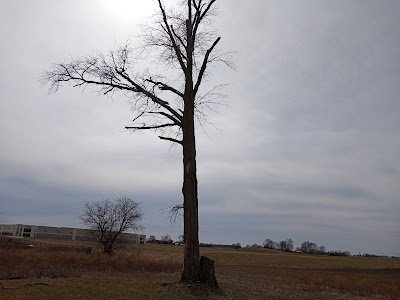How will we be remembered after we're gone? What will be left of our lives and our legacy once we're dead? Are there really any more quintessential questions to face? As you get older, you start to think about these things and there seem to be more and more occasions to dwell upon them.
Behind our house is a farmer's field, at least for the time being. During the fallow season it's a place we sometimes go walking down, at least on the edge, to get some exercise and look at the huge retaining pond put in as a barrier between one of the large shipping warehouses in the area and our subdivision. There are at least four such warehouses clustered together, with docking bays to load up semis to hit the nearby interstate on-ramp.
When it was very snowy a few months ago, we went on one of these walks and I spotted some odd stones in the distance under a few lone, skeletal trees. Recently, when I had the time and the weather was better, I took a trip back and discovered, to my surprise, that the stones belonged to a small nineteenth century family grave. Here is a picture of the cemetery, where its proximity to the warehouse is apparent.
In this image, from further away, you can make out the warehouses bounding the cemetery on the south and east. You can just make out the monument stones in between the trees.
Here is a close-up of the foreboding tree nearest the graves. It's rather a spooky place to be - even with another warehouse lurking in the background.
I began to wonder who the people buried in these plots were and I took photos of the stones where the inscriptions were still legible and had not yet been worn down by time and the elements.
Though I am a neophyte at this sort of research, after doing some internet sleuthing and delving into sources available through the kind help of the county historical society, I've been able to garner some information about those interred at this site. As the name on the stone in the picture above suggests, this very small site is usually known as "Smith Cemetery," but alternately as "Thornley Cemetery" based on the name of a small village that used to exist nearby. Twelve individuals (half from the Smith family) are buried there with the only information available pertaining to members of the Smith family, primarily the patriarch, William Warren Smith. It seems that Smith was originally born near Baltimore in November 1814. (For history buffs, that's just a couple of months after the Battle of Baltimore, the event during the War of 1812 that inspired the composition of the "Star Spangled Banner.") After living in Virginia for a time, Smith and his brother moved to Ohio, where he met and married Catharine Weaver - the Catharine Smith whose marker is pictured above. William and Catharine had two daughters in Ohio, with the oldest dying shortly after birth. In 1842, William and Catharine moved west to Boone County, Indiana, presumably to search out better prospects for land. According to the old record book Early Life and Times in Boone County (1887):
frogs croaked, owls hooted, and wolves howled. In the midst of all this they
Though there are still many gaps, not least of which being the history of the other six individuals buried in the cemetery, it is a thrilling and strangely humbling experience to discover these facts and even look upon a picture of a person related to the people who lived in that space.
My feelings are tempered, though, by the future of the area. With the proximity and quantity of warehouses going in, the site will become increasingly closed off and inaccessible, even to the point of vanishing as so-called development encroaches on the cemetery. Right now, the north and west (shown below) is the only area of the cemetery not closed off by buildings.
This will all change in a few months when the area pictured above will become the site of -- you guessed it -- yet another shipping warehouse, meaning the Smith Cemetery will have such structures surrounding it from all four directions. This small piece of history, the legacy of these individuals, will be ground under the wheels of the industrialized consumerist complex, sacrificed on the altar of capitalistic shipping efficiency, with nothing in sight but acres and acres of concrete. Is that how any of us would want to be remembered?
Iron wills or not, in the great gulf of space and time, we will all be forgotten. However, there's something about the way this cemetery is being symbolically erased that profoundly bothers me. Without being remembered, did we ever really live at all? If we can at least remember these people, in a way it's a kind of resistance, like the plant that persists to burrow its way up through layers of asphalt and concrete. In a way, soon enough, that's rather like what this cemetery will be: a tiny oasis of human culture and memory attempting to persist amid the arid desert of commercialism.










No comments:
Post a Comment